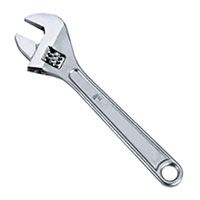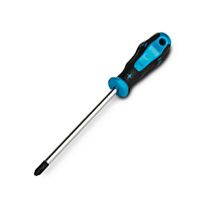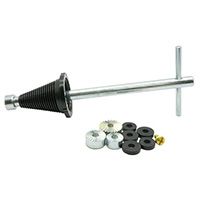We may be compensated if you purchase through links on our website. Our team is committed to delivering honest, objective, and independent reviews on home products and services.
Project details
Skill
Cost
Estimated Time
A leaky outdoor faucet can waste water and increase your utility bills. Repairing a dripping hose spigot is often a simple do-it-yourself (DIY) project that most homeowners can tackle with basic tools and materials. This guide will walk you through the process of identifying the source of the leak and making the necessary repairs. This Old House’s plumbing and heating expert, Richard Trethewey, demonstrates how to fix common issues with outdoor faucets in the video above.
Common Causes of Leaky Hose Spigots
Before attempting any repairs, pinpoint the problem area. There are typically two main areas where leaks occur: at the bonnet or at the spout.
The bonnet is the top part of the spigot that holds the stem in place. Leaks in this area often result from the following:
- Damaged O-ring
- Loose bonnet nut
- Worn bonnet packing
When water drips from the spout even when the handle is in the off position, the issue is usually related to one of the following:
- Damaged valve seat
- Loose packing nut
- Worn washer at the base of the stem
Tools and Materials Needed To Fix a Leaky Hose Spigot
Before you start the repair, gather the following tools and materials:
- Adjustable wrench
- Screwdriver (Phillips head)
- Replacement washers
- Packing material or Teflon tape
- Reseating tool (optional)
- Spare washer kit
How To Fix a Leak at the Bonnet
Leaks at the bonnet can often be fixed with minimal effort. Tightening the bonnet nut with an adjustable wrench usually works, but if it doesn’t, follow these steps:
- Turn off the water supply to the spigot to prevent any water flow during the repair.
- Remove the handle and unscrew the bonnet nut to gain access to the internal components.
- Inspect the bonnet packing and replace it if it’s worn. Over time, this component can deteriorate and need replacement. Trethewey suggests using Teflon tape as a DIY solution if you don’t have a replacement bonnet packing on hand.
- Reassemble the spigot and test for leaks to make sure the issue is resolved.
How To Repair a Leak at the Spout
Leaks at the spout, also known as drips, can waste significant water over time. For leaks that occur at the spout when the faucet is off, follow these steps:
- Shut off the water supply to the spigot to prevent water flow during the repair. A pipe wrench may be necessary for stubborn valves.
- Remove the handle and unscrew the bonnet nut to access the stem unit. This may require some force if the unit is corroded.
- Unscrew the stem unit from the valve body.
- Locate the screw at the bottom of the stem and remove it carefully. Use the correct size Phillips head screwdriver to avoid stripping the screw.
- Replace the old washer with a new one from your repair kit. Ensure it’s the right size for your spigot model.
- Reassemble the stem unit and reinstall it in the valve body, being cautious to avoid cross-threading.
- Turn the water back on and test the spigot to make sure the leak is resolved.
If the leak persists after replacing the washer, the valve seat may be damaged and require reseating. The valve seat can become worn over time, leading to leaks. A reseating tool can help smooth out a damaged valve seat and provide a fresh, clean surface for the washer to seal against. Here’s how to use a reseating tool:
- Insert the reseating tool into the valve body, ensuring it is properly aligned.
- Apply gentle pressure and rotate the tool to grind the seat surface. Be consistent to avoid uneven grinding.
- Clean out any debris thoroughly with a small brush or cloth before reassembling the spigot.
- Test the faucet once more to check that the leak is resolved and the seat is smooth and effective.
Preventative Maintenance for Outdoor Spigots
To avoid future leaks and extend the life of your outdoor faucets, consider incorporating regular maintenance into your routine. Simple preventative measures can save time and money in the long run. Complete the following:
- Avoid overtightening the handle when shutting off the water.
- Drain and winterize outdoor faucets before freezing temperatures arrive to prevent pipe bursts and leaks.
- Inspect spigots annually for signs of wear or damage.
- Use hose timers to prevent overuse and unnecessary wear.
Troubleshooting Persistent Spigot Leaks
Persistent issues may indicate more complex problems. If you’ve attempted the above repairs but you’re still experiencing leaks, consider these additional steps:
- Check for cracks in the valve body or spout, which may require a complete replacement of the spigot.
- If the spigot is old or severely damaged, consider replacing it. Modern spigots may offer better performance and durability.
- Inspect the pipe leading to the spigot for damage or corrosion. These issues can lead to leaks and may require professional assessment.
- Verify that the water pressure isn’t exceeding the spigot’s rating, which can cause leaks and damage over time.
Persistent leaks may require the expertise of a professional plumber to resolve. Attempting more complex repairs without the right knowledge can lead to further damage.
When To Call a Professional
While many hose spigot repairs are DIY-friendly, there are situations when we suggest getting professional help. Recognizing when to call a professional can save you time and prevent potential damage. Here are a few cases when you should phone a pro:
- If you suspect a more significant plumbing issue beyond the spigot.
- If you’re uncomfortable working with plumbing systems.
- When local building codes require licensed plumbers for certain repairs.
- When repairs involve accessing pipes within walls, as these often require specialized tools and knowledge.
Resources:
The spare washer kit, Teflon tape, and spigot repair tools can all be found at home centers and plumbing supply houses.



